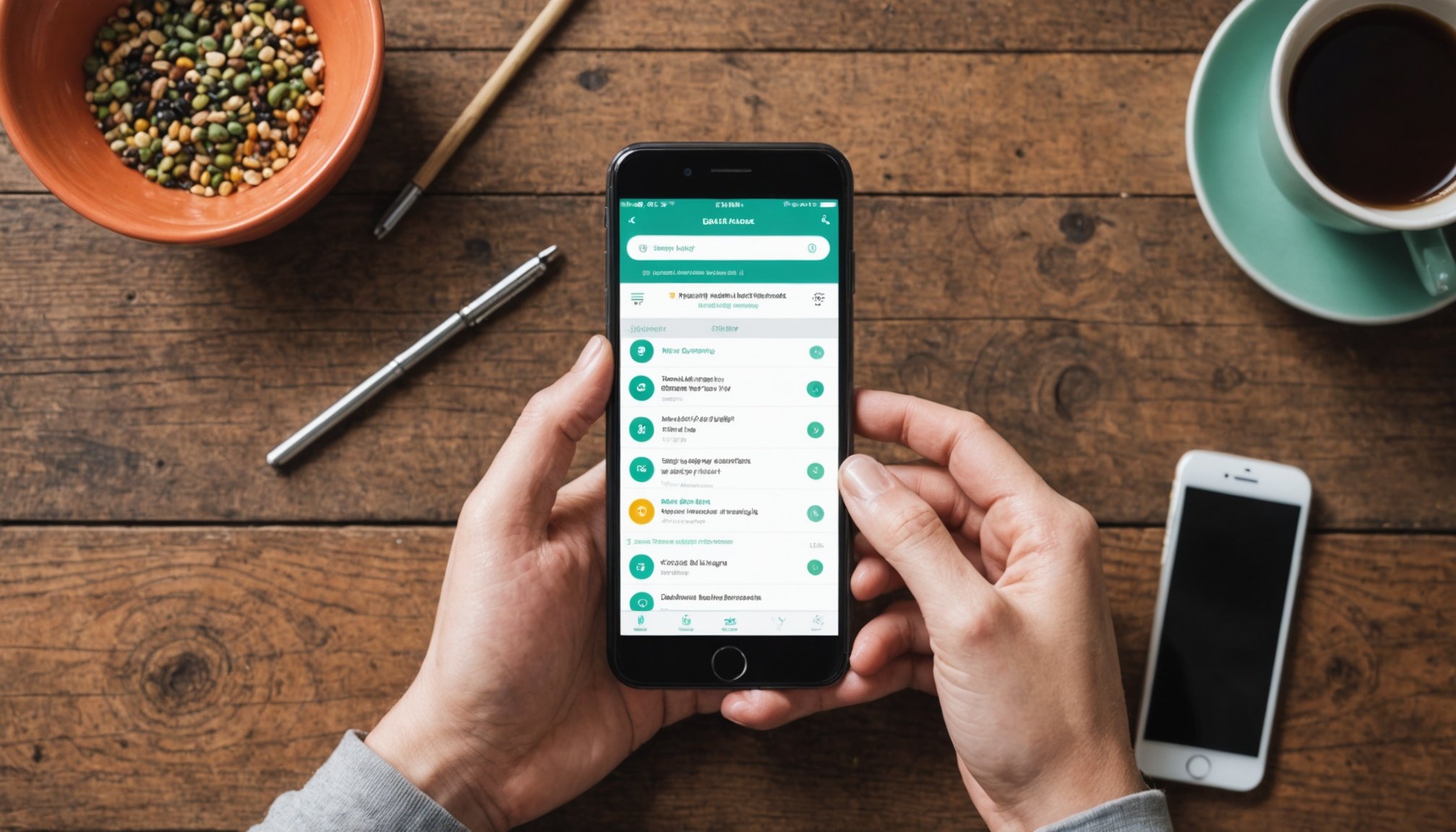Unlocking Your Wellness: The Ultimate Smartphone Guide to Crafting a Personalized Digital Health Journal
In the era of smartphones and advanced health technologies, managing your health has never been more accessible or personalized. This guide will walk you through the process of creating a tailored digital health journal using your smartphone, helping you to better track, manage, and improve your overall well-being.
Understanding the Power of Digital Health
Digital health, encompassing eHealth, mHealth, telehealth, and other technologies, has revolutionized the way we approach healthcare. These innovations are not just tools but integral components of modern healthcare, enhancing patient care, improving outcomes, and making healthcare more accessible[2].
In parallel : Enhance Your Living Space with Smart Lighting: Effortlessly Manage It from Your Smartphone
What is Digital Health?
Digital health includes a broad range of technologies and services that leverage information and communication technology (ICT) to enhance health. This includes mobile health (mHealth) apps, telehealth services, wearable devices, and artificial intelligence (AI) in healthcare. For instance, mHealth apps allow users to monitor their health metrics, schedule appointments, and access educational resources, all from the convenience of their smartphones[2].
Choosing the Right Health Apps
With thousands of health apps available on the Google Play Store and the App Store, selecting the right ones can be overwhelming. Here are some key considerations and recommendations to help you make informed choices.
Also read : Transform Your Space: Harness Your Smartphone to Build the Ultimate Smart Workout Zone
Key Features to Look For
- Data Tracking: Look for apps that can track various health metrics such as heart rate, steps taken, and sleep patterns.
- User-Friendly Interface: An intuitive interface is crucial for consistent use. Apps like MyFitnessPal and Fitbit offer user-friendly designs that make tracking easy.
- Integration with Wearables: If you use a wearable device, ensure the app integrates seamlessly with it.
- Privacy and Security: Check the app’s privacy policy to ensure your data is secure.
- Reviews and Ratings: Read reviews from other users to get a sense of the app’s effectiveness and any potential issues.
Top Health Apps for Your Digital Health Journal
- MyFitnessPal: Excellent for tracking diet and nutrition.
- Integrates with many wearable devices.
- Large database of foods.
- User-friendly interface.
- Fitbit Coach: Ideal for personalized fitness plans.
- Offers video workouts tailored to your fitness level.
- Integrates with Fitbit wearables.
- Tracks progress over time.
- Headspace: A leading app for mental health and meditation.
- Guided meditation sessions.
- Personalized meditation plans.
- Tracks progress and provides insights.
Building Your Digital Health Journal
Creating a comprehensive digital health journal involves more than just downloading apps. Here’s a step-by-step guide to help you get started.
Mapping Your Patient Journey
Understand the different stages of your health journey, from awareness and information-seeking to ongoing health monitoring. This will help you identify where digital health tools can make the most impact[5].
Stages of the Patient Journey
- Awareness and Information-Seeking: Use apps like Google Scholar or medical websites to gather information about your health conditions.
- Appointment Scheduling and Pre-Visit Preparation: Apps like Zocdoc or your healthcare provider’s app can help you schedule appointments and prepare for visits.
- In-Person or Virtual Care Delivery: Telehealth apps such as Teladoc allow for remote consultations.
- Post-Visit Follow-Up and Care Management: Use patient portals like MyChart to access your health records and follow-up instructions.
- Ongoing Health Monitoring and Prevention: Wearable devices and apps like Apple Health or Google Fit track your health metrics in real time.
Evaluating and Implementing Digital Health Solutions
Once you’ve identified the gaps in your health journey, it’s time to evaluate and implement the right digital health solutions.
Assessing Scaling Needs
Determine whether you need automation, augmentation, acceleration, optimization, or deflection of tasks through digital solutions. For example, automating reminders for medication or augmenting your workout routine with digital fitness coaches[5].
Choosing Between Platform Solutions and Point Solutions
Decide whether you need a comprehensive platform or targeted point solutions. Platform solutions like Apple Health integrate various health metrics, while point solutions like Headspace focus on specific areas like mental health[5].
Integrating Digital Health Tools into Your Workflow
For digital health tools to be effective, they must integrate seamlessly into your daily routine.
User Experience
Ensure the apps you choose have a user-friendly interface. For instance, apps with simple navigation and clear data visualization can make tracking your health easier and more enjoyable.
Training and Support
Many apps offer tutorials or support resources to help you get started. Take advantage of these to maximize the use of the app.
Integration with Existing Systems
Ensure the apps integrate with your existing health records and wearable devices. For example, Fitbit integrates well with electronic health records (EHRs) and other health apps[5].
Overcoming Common Challenges
Implementing a digital health journal can come with several challenges, but with the right strategies, you can overcome them.
Addressing Patient and Workforce Disconnection
Use tools that enhance communication between patients and providers. For example, patient engagement apps can provide easy access to health information and improve care coordination among healthcare teams[5].
Gaining Physician Buy-In
Physician support is crucial for the success of any digital health initiative. Conduct one-on-one meetings or focus groups to understand their needs and concerns. This can help build trust and support for digital health solutions[5].
Case Study: Successful Implementation of Digital Health Journals
A case study from Florida State University highlights the importance of interdisciplinary collaboration in digital health innovation. Researchers and healthcare professionals worked together to propose novel solutions using digital tools, resulting in personalized healthcare experiences tailored to individual needs. This collaboration led to the development of integrated digital platforms offering remote monitoring services and customized treatment plans based on data analytics insights from wearable devices and mobile applications[4].
Practical Insights and Actionable Advice
Here are some practical tips to help you make the most out of your digital health journal:
Start Small
Begin with a few apps and gradually add more as you become more comfortable with using them.
Be Consistent
Make tracking your health a part of your daily routine, just like brushing your teeth or taking a shower.
Use Real-Time Data
Leverage real-time data from wearables and apps to make informed decisions about your health.
Focus on Mental Health
Don’t forget to include mental health apps in your journal. Mental health is just as important as physical health, and apps like Headspace can provide valuable support.
Stay Updated
Regularly update your apps to ensure you have the latest features and security patches.
Table: Comparing Top Health Apps
Here is a comparative table of some top health apps to help you make an informed decision:
| App Name | Key Features | Integration | Pricing | User Rating |
|---|---|---|---|---|
| MyFitnessPal | Diet tracking, large food database, barcode scanner | Wearable devices | Free, Premium | 4.8/5 |
| Fitbit Coach | Personalized fitness plans, video workouts | Fitbit wearables | Free, Premium | 4.7/5 |
| Headspace | Guided meditation sessions, personalized plans | None | Free, Premium | 4.9/5 |
| Apple Health | Tracks various health metrics, integrates with Apple Watch | Apple devices | Free | 4.8/5 |
| Google Fit | Tracks activity, integrates with Google Wear OS | Google devices | Free | 4.5/5 |
Quotes from Experts
- “Digital health is not just about technology; it’s about how we can use these tools to improve patient outcomes and enhance the overall healthcare experience,” – Geraint Walker, Clinical Informaticist, Digital Health and Care Wales[3].
- “The success of digital health collaborations often hinges on establishing clear communication channels and standardized protocols among participating entities,” – Collaborative Innovations in Digital Health Guide[4].
Creating a personalized digital health journal is a powerful step towards taking control of your health. By understanding the various stages of your health journey, selecting the right apps, and integrating these tools into your daily routine, you can significantly improve your health outcomes. Remember, the key to success lies in consistency, user-friendly interfaces, and seamless integration with existing systems. With the right approach, you can unlock the full potential of digital health and embark on a journey towards better wellness.
Additional Resources
For further reading and resources, you can explore the following:
- BMJ Group’s Digital Health Solutions: Offers evidence-based tools and services to support healthcare professionals and patients[3].
- Digital Health Journal: A peer-reviewed open access journal focusing on the evolution of advances in informatics and technology in medicine and healthcare[1].
- Google Scholar: A valuable resource for researching the latest studies and research in digital health[5].
By leveraging these resources and following the guidelines outlined in this article, you can create a comprehensive and effective digital health journal that enhances your overall well-being.











